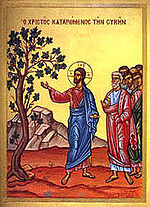Cursing of the fig tree
| Events in the |
| Life of Jesus according to the canonical gospels |
|---|
 |
|
Portals: |
The cursing of the fig tree is an incident from the synoptic gospels. In Mark and Matthew it is presented as a miracle in connection with the entry into Jerusalem.[1] Based on the Old Testament symbol of the fig tree under which men of the new age will sit in peace and security, its message is that Israel has failed, and will be destroyed, just as the fig tree withers and dies.[1][2]
Commentary

Most scholars believe that Mark was the first gospel and was used as a source by the authors and Luke.[3]
Traditional Christian exegesis regarding these accounts include affirmation of the Divinity of Jesus by demonstrating his authority over nature. Traditional Reformed thinking states that this event was a sign given by Jesus of the end of the exclusive covenant between God and the Jews – see also Supersessionism. According to this interpretation, the tree is a metaphor for the Jewish nation, i.e., it had the outward appearance of godly grandeur (the leaves), but it was not producing anything for God's glory (the lack of fruit).
This interpretation is connected to the parable of the barren fig tree.[4]
F. F. Bruce states that fig trees produce "taqsh" before the season if they are going to bear fruit in the season itself. Since this one didn't, it was a sign that it would not produce any fruit that year either.[5] Theology professor Craig Keener has used these passages as a reason for an early dating for the Gospel of Matthew, saying only someone with a close knowledge of the Mount of Olives would have known that its fig trees come out in leaves around the Passover time of year.[6]
Parallels in other texts
In the Gospel of Luke, a similar story is told as one of Jesus’ parables known as the Parable of the barren fig tree. It has very similar wording to Mark and Matthew.
A very different story appears in Infancy Gospel of Thomas, but has a similar quotation from Jesus: "…behold, now also thou shalt be withered like a tree, and shalt not bear leaves, neither root, nor fruit." (III:2).[7]
See also
- Figs in the Bible
- Life of Jesus in the New Testament
- Parable of the budding fig tree
- Parable of the barren fig tree
References
Citations
- ^ a b Dumbrell 2001, p. 67.
- ^ Kinman 1995, p. 123.
- ^ Burkett 2002, p. 143.
- ^ Richard Whately, Lectures on Some of the Scripture Parables, John W. Parker and Son, 1859, p. 153.
- ^ Bruce, Frederick, 1992, "Are The New Testament Documents Reliable?", ISBN 0-8028-2219-3, p 73-74.
- ^ Keener, Craig, 1999, "A Commentary on the Gospel of Matthew", ISBN 0-8028-3821-9, p 504.
- ^ James, M. R., 1924, The Apocryphal New Testament, Oxford: Clarendon Press
Bibliography
- Burkett, Delbert Royce (2002). An introduction to the New Testament and the origins of Christianity. Cambridge University Press.
{{cite book}}: Invalid|ref=harv(help) - Dumbrell, W.J. (2001). The Search for Order: Biblical Eschatology in Focus. Wipf and Stock.
{{cite book}}: Invalid|ref=harv(help) - Kinman, Brent (1995). Jesus' entry into Jerusalem: in the context of Lukan theology and the politics of his day. Brill.
{{cite book}}: Invalid|ref=harv(help) - Keener, Craig (1999). A Commentary on the Gospel of Matthew. Eerdmans.
{{cite book}}: Invalid|ref=harv(help)

